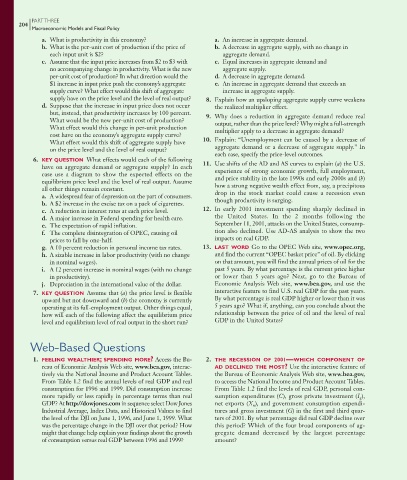Page 233 - Economics
P. 233
CONFIRMING PAGES
PART THREE
204
Macroeconomic Models and Fiscal Policy
a. What is productivity in this economy? a. An increase in aggregate demand.
b. What is the per-unit cost of production if the price of b. A decrease in aggregate supply, with no change in
each input unit is $2? aggregate demand.
c. Assume that the input price increases from $2 to $3 with c. Equal increases in aggregate demand and
no accompanying change in productivity. What is the new aggregate supply.
per-unit cost of production? In what direction would the d. A decrease in aggregate demand.
$1 increase in input price push the economy’s aggregate e. An increase in aggregate demand that exceeds an
supply curve? What effect would this shift of aggregate increase in aggregate supply.
supply have on the price level and the level of real output? 8. Explain how an upsloping aggregate supply curve weakens
d. Suppose that the increase in input price does not occur the realized multiplier effect.
but, instead, that productivity increases by 100 percent. 9. Why does a reduction in aggregate demand reduce real
What would be the new per-unit cost of production? output, rather than the price level? Why might a full-strength
What effect would this change in per-unit production multiplier apply to a decrease in aggregate demand?
cost have on the economy’s aggregate supply curve?
What effect would this shift of aggregate supply have 10. Explain: “Unemployment can be caused by a decrease of
on the price level and the level of real output? aggregate demand or a decrease of aggregate supply.” In
each case, specify the price-level outcomes.
6. KEY QUESTION What effects would each of the following
have on aggregate demand or aggregate supply? In each 11. Use shifts of the AD and AS curves to explain (a) the U.S.
case use a diagram to show the expected effects on the experience of strong economic growth, full employment,
equilibrium price level and the level of real output. Assume and price stability in the late 1990s and early 2000s and (b)
all other things remain constant. how a strong negative wealth effect from, say, a precipitous
a. A widespread fear of depression on the part of consumers. drop in the stock market could cause a recession even
b. A $2 increase in the excise tax on a pack of cigarettes. though productivity is surging.
c. A reduction in interest rates at each price level. 12. In early 2001 investment spending sharply declined in
d. A major increase in Federal spending for health care. the United States. In the 2 months following the
e. The expectation of rapid inflation. September 11, 2001, attacks on the United States, consump-
f. The complete disintegration of OPEC, causing oil tion also declined. Use AD-AS analysis to show the two
prices to fall by one-half. impacts on real GDP.
g. A 10 percent reduction in personal income tax rates. 13. LAST WORD Go to the OPEC Web site, www.opec.org,
h. A sizable increase in labor productivity (with no change and find the current “OPEC basket price” of oil. By clicking
in nominal wages). on that amount, you will find the annual prices of oil for the
i. A 12 percent increase in nominal wages (with no change past 5 years. By what percentage is the current price higher
in productivity). or lower than 5 years ago? Next, go to the Bureau of
j. Depreciation in the international value of the dollar. Economic Analysis Web site, www.bea.gov, and use the
7. KEY QUESTION Assume that (a) the price level is flexible interactive feature to find U.S. real GDP for the past years.
upward but not downward and (b) the economy is currently By what percentage is real GDP higher or lower than it was
operating at its full-employment output. Other things equal, 5 years ago? What if, anything, can you conclude about the
how will each of the following affect the equilibrium price relationship between the price of oil and the level of real
level and equilibrium level of real output in the short run? GDP in the United States?
Web-Based Questions
1. FEELING WEALTHIER; SPENDING MORE? Access the Bu- 2. THE RECESSION OF 2001—WHICH COMPONENT OF
reau of Economic Analysis Web site, www.bea.gov, interac- AD DECLINED THE MOST? Use the interactive feature of
tively via the National Income and Product Account Tables. the Bureau of Economic Analysis Web site, www.bea.gov,
From Table 1.2 find the annual levels of real GDP and real to access the National Income and Product Account Tables.
consumption for 1996 and 1999. Did consumption increase From Table 1.2 find the levels of real GDP, personal con-
more rapidly or less rapidly in percentage terms than real sumption expenditures (C), gross private investment (I g ),
GDP? At http://dowjones.com in sequence select Dow Jones net exports (X n ), and government consumption expendi-
Industrial Average, Index Data, and Historical Values to find tures and gross investment (G) in the first and third quar-
the level of the DJI on June 1, 1996, and June 1, 1999. What ters of 2001. By what percentage did real GDP decline over
was the percentage change in the DJI over that period? How this period? Which of the four broad components of ag-
might that change help explain your findings about the growth gregate demand decreased by the largest percentage
of consumption versus real GDP between 1996 and 1999? amount?
8/21/06 4:51:12 PM
mcc26632_ch10_187-207.indd 204 8/21/06 4:51:12 PM
mcc26632_ch10_187-207.indd 204

